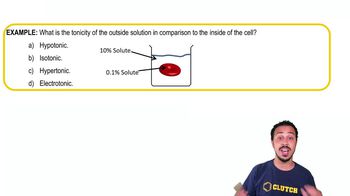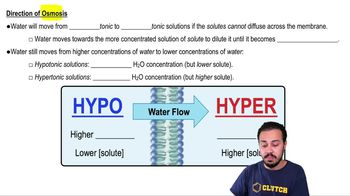Table of contents
- 1. Introduction to Biology2h 42m
- 2. Chemistry3h 40m
- 3. Water1h 26m
- 4. Biomolecules2h 23m
- 5. Cell Components2h 26m
- 6. The Membrane2h 31m
- 7. Energy and Metabolism2h 0m
- 8. Respiration2h 40m
- 9. Photosynthesis2h 49m
- 10. Cell Signaling59m
- 11. Cell Division2h 47m
- 12. Meiosis2h 0m
- 13. Mendelian Genetics4h 44m
- Introduction to Mendel's Experiments7m
- Genotype vs. Phenotype17m
- Punnett Squares13m
- Mendel's Experiments26m
- Mendel's Laws18m
- Monohybrid Crosses19m
- Test Crosses14m
- Dihybrid Crosses20m
- Punnett Square Probability26m
- Incomplete Dominance vs. Codominance20m
- Epistasis7m
- Non-Mendelian Genetics12m
- Pedigrees6m
- Autosomal Inheritance21m
- Sex-Linked Inheritance43m
- X-Inactivation9m
- 14. DNA Synthesis2h 27m
- 15. Gene Expression3h 20m
- 16. Regulation of Expression3h 31m
- Introduction to Regulation of Gene Expression13m
- Prokaryotic Gene Regulation via Operons27m
- The Lac Operon21m
- Glucose's Impact on Lac Operon25m
- The Trp Operon20m
- Review of the Lac Operon & Trp Operon11m
- Introduction to Eukaryotic Gene Regulation9m
- Eukaryotic Chromatin Modifications16m
- Eukaryotic Transcriptional Control22m
- Eukaryotic Post-Transcriptional Regulation28m
- Eukaryotic Post-Translational Regulation13m
- 17. Viruses37m
- 18. Biotechnology2h 58m
- 19. Genomics17m
- 20. Development1h 5m
- 21. Evolution3h 1m
- 22. Evolution of Populations3h 52m
- 23. Speciation1h 37m
- 24. History of Life on Earth2h 6m
- 25. Phylogeny2h 31m
- 26. Prokaryotes4h 59m
- 27. Protists1h 12m
- 28. Plants1h 22m
- 29. Fungi36m
- 30. Overview of Animals34m
- 31. Invertebrates1h 2m
- 32. Vertebrates50m
- 33. Plant Anatomy1h 3m
- 34. Vascular Plant Transport1h 2m
- 35. Soil37m
- 36. Plant Reproduction47m
- 37. Plant Sensation and Response1h 9m
- 38. Animal Form and Function1h 19m
- 39. Digestive System1h 10m
- 40. Circulatory System1h 57m
- 41. Immune System1h 12m
- 42. Osmoregulation and Excretion50m
- 43. Endocrine System1h 4m
- 44. Animal Reproduction1h 2m
- 45. Nervous System1h 55m
- 46. Sensory Systems46m
- 47. Muscle Systems23m
- 48. Ecology3h 11m
- Introduction to Ecology20m
- Biogeography14m
- Earth's Climate Patterns50m
- Introduction to Terrestrial Biomes10m
- Terrestrial Biomes: Near Equator13m
- Terrestrial Biomes: Temperate Regions10m
- Terrestrial Biomes: Northern Regions15m
- Introduction to Aquatic Biomes27m
- Freshwater Aquatic Biomes14m
- Marine Aquatic Biomes13m
- 49. Animal Behavior28m
- 50. Population Ecology3h 41m
- Introduction to Population Ecology28m
- Population Sampling Methods23m
- Life History12m
- Population Demography17m
- Factors Limiting Population Growth14m
- Introduction to Population Growth Models22m
- Linear Population Growth6m
- Exponential Population Growth29m
- Logistic Population Growth32m
- r/K Selection10m
- The Human Population22m
- 51. Community Ecology2h 46m
- Introduction to Community Ecology2m
- Introduction to Community Interactions9m
- Community Interactions: Competition (-/-)38m
- Community Interactions: Exploitation (+/-)23m
- Community Interactions: Mutualism (+/+) & Commensalism (+/0)9m
- Community Structure35m
- Community Dynamics26m
- Geographic Impact on Communities21m
- 52. Ecosystems2h 36m
- 53. Conservation Biology24m
6. The Membrane
Osmosis
Problem 4`
Textbook Question
A plant cell placed in distilled water will ______________; an animal cell placed in distilled water will ______________. a. burst … burst b. become flaccid . . . shrivel c. become turgid . . . be normal in shape d. become turgid . . . burst
 Verified step by step guidance
Verified step by step guidance1
Understand the concept of osmosis: Osmosis is the movement of water across a selectively permeable membrane from an area of lower solute concentration to an area of higher solute concentration.
Recognize the difference between plant and animal cells: Plant cells have a rigid cell wall that provides structural support, while animal cells lack a cell wall and only have a flexible plasma membrane.
Analyze the effect of distilled water on plant cells: Distilled water is hypotonic (lower solute concentration compared to the cell's cytoplasm). Water will move into the plant cell, causing it to swell and become turgid due to the pressure exerted by the cell wall.
Analyze the effect of distilled water on animal cells: In the absence of a cell wall, water entering the animal cell in a hypotonic environment will cause the cell to swell and eventually burst (lyse) due to the lack of structural support.
Match the observations to the answer choices: Based on the analysis, the correct answer is 'd. become turgid . . . burst,' as plant cells become turgid and animal cells burst when placed in distilled water.
 Verified video answer for a similar problem:
Verified video answer for a similar problem:This video solution was recommended by our tutors as helpful for the problem above
Video duration:
1mPlay a video:
Was this helpful?
Key Concepts
Here are the essential concepts you must grasp in order to answer the question correctly.
Osmosis
Osmosis is the movement of water molecules across a selectively permeable membrane from an area of lower solute concentration to an area of higher solute concentration. This process is crucial for maintaining cell turgor in plants and the overall balance of fluids in animal cells. Understanding osmosis helps explain how cells respond to different environments, such as when placed in distilled water.
Recommended video:
Guided course

Osmosis
Turgor Pressure
Turgor pressure is the pressure exerted by the fluid inside the central vacuole of a plant cell against the cell wall. This pressure is essential for maintaining the structural integrity and rigidity of plant cells. When a plant cell is placed in distilled water, it absorbs water, increasing turgor pressure, which can lead to the cell becoming turgid.
Recommended video:
Guided course

Pressure Potential and Turgidity
Cell Membrane Permeability
Cell membrane permeability refers to the ability of the cell membrane to allow certain substances to pass through while blocking others. In animal cells, the membrane is more permeable to water than to solutes, which can lead to osmotic imbalances. When an animal cell is placed in distilled water, it may take in too much water, potentially causing it to burst due to the lack of a rigid cell wall.
Recommended video:
Guided course

Introduction to Membrane Transport
Related Videos
Related Practice














